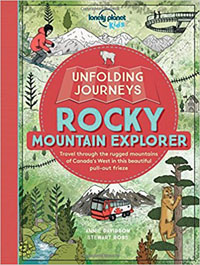| ________________
CM . . .
. Volume XXIII Number 28. . . .March 31, 2017

 |
Unfolding Journeys Rocky Mountain Explorer.
Stewart Ross. Illustrated by Annie Davidson.
Oakland, CA: Lonely Planet (Distributed in Canada by Raincoast Books), 2016.
16 pp., hardcover, $24.99.
ISBN 978-1-78657-107-6.
Grades 1-6 / Ages 6-11.
Review by Harriet Zaidman.
** /4
|
| |
|

excerpt:
Hold on tight! We’ve left the train
for the afternoon and are rafting
through the JAWS OF DEATH!
Children love foldout books; the format encourages close examination of the pictures and accompanying text. Lonely Planet, famous for its travel guides, has published the new “Unfolding Journeys” series (the other title is Amazon Adventure). Despite its provenance, however, this travel guide is physically unwieldy and lacks key information that should be expected in a publication in this genre.
The 9 inch x 12 inch connected heavy card pages are double sided. The front side shows drawings of the train route from Vancouver to Calgary, with numbered locations and natural phenomena, such as the Golden Eagle: “Look! There’s a GOLDEN EAGLE soaring over the mountainside”, some significant locations: “Traveling on a bridge over the FRASER CANYON is like being in a Western!” and some contemporary activities: “Ginseng Farms – The nets on this farm are covering GINSENG PLANTS. The shade persuades them they’re growing in a dark forest, their natural environment.” Annie Davidson’s ink and watercolour drawings are detailed, from the miniature windows in the skyscrapers in Vancouver to the leaves on the different types of trees in the forests along the train track. Shades of green predominate, and the grey mountains rise above the forests. Trains, buildings and bodies of water fill in the rest of the busy landscape.
The flip side elaborates on the numbered captions. Some of the text is useful, informing children about the history of the area, the animals, the challenges of travelling in mountainous terrain; some are curious choices for a children’s publication:
Some people believe the root of the ginseng plant has great health benefits. It’s said to help with all kinds of medical conditions, from stress to cancer. Doctors are unsure about the plant’s value, but the farmers in this region aren’t. They have been growing ginseng since 1982.
High in the Rockies the air is dry, clean, and fresh. This is ideal for keeping valuable ginseng roots free from disease. After about four years, when the roots are looking a bit like hairy, creamy white carrots, they are ready to be harvested, dried, and manufactures into the popular medicine.
Who are the some people who farm the gensing? Is ginseng farming such a huge enterprise that it takes up vast amounts of agricultural space? The inclusion of this information for children, when compared to facts about the grizzly bear, the nesting osprey and the McClure Fire, seems unusual. Similarly, the reference to Westerns is not explained in the paragraphs about the Fraser Canyon Gold Rush. How many of today’s children know what a Western is?
Information about the city of Kamloops tells the young reader the origins of the city’s name and details about its location. However, neither Kamloops nor any other city the train visits on its journey through the Rockies is indicated anywhere on the fairly small map found in the “Rockies Fact File” that forms part of the back cover. A tiny map of the world shows Canada in green. An enlargement of the west coast has a strip of brown running through it, representing the Rocky Mountains. But the towns and cities listed in the drawings on the first side of the book, Vancouver, Mission, Hell’s Gate, the Fraser Canyon, Avalanche Alley, Route 93, the Columbia Icefield, Athabaska Falls, Banff, etc., are not pinpointed for children to see on a map. It’s puzzling, considering this is supposed to be a travel guide for children.
Physically, the publication is hard to handle, and one can only imagine the trouble a child might have in the back of the car on a family trip, trying to flip from the numbered pictures on the front to the corresponding information on the back. The pages, linked together, are nearly 7 feet long! Manipulating the stiff paper stock in a confined area would be an exercise in frustration for a single child and a guaranteed source of annoyance to anyone else occupying the back seat.
Parents and relatives buy informational books to educate children about the places the kids visit on vacation, to give them a window into a variety of topics, including history and geography. Lonely Planet is likely an ideal company to produce useful, interesting materials for children of all ages. But the pullout book’s design and the eclectic material included mean Rocky Mountain Explorer doesn’t meet a purchaser’s expectations.
Recommended with Reservations.
Harriet Zaidman is a teacher-librarian in Winnipeg, MB.

To comment
on this title or this review, send mail to cm@umanitoba.ca.
Copyright © the Manitoba Library Association. Reproduction for personal
use is permitted only if this copyright notice is maintained. Any
other reproduction is prohibited without permission.
Next Review | Table of Contents For This Issue - March 31, 2017
CM Home | Back Issues
| Search
| CM Archive
| Profiles Archive
|
